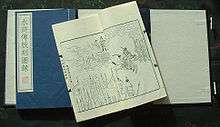Traditional Chinese bookbinding


Traditional Chinese bookbinding, also called stitched binding (Chinese: xian zhuang), is the method of bookbinding that the Chinese, Koreans, Japanese, and Vietnamese used before adopting the modern codex form. [1]
History
The earliest known form of bookbinding in China is "butterfly binding" (Chinese: 蝴蝶裝), which was invented during the Song Dynasty (around 1000 C.E.). Single-printed folio pages were pasted together and folded in a stack, creating a book in which pairs of printed pages alternated with blank ones. This was followed by "wrapped back binding", in which the folios were complied with the image on the outside, and the open ends at the spine. Stitched binding developed from wrapped back binding in the sixteenth century.[2]
Materials
The paper used as the leaves are usually xuan paper (宣紙). This is an absorbent paper used in traditional Chinese calligraphy and painting. Stronger and better quality papers may be used for detailed works that involve multicoloured woodblock printing. The covers tend to be a stronger type of paper, dyed dark blue. Yellow silk can be used, which is more predominant in imperially commissioned works. The cover is then backed by normal xuan paper to give it more strength. Hardcovers are rare and only used in very important books; The silk cord is almost always white. The case for the books are usually made of wood or bookboard, covered with cloth or silk and the inside is covered in paper.
Method
The method of this binding is in several stages:
- The first stage is to fold the printed paper sheets. The printing method was to print on a large sheet, then fold it in half so the text appears on both sides.
- The second stage is to gather all the folded leaves into order and assemble the back and front covers. Important or luxury edition books have a further single leaf inserted in the fold of the leaves. Front covers tend to be replaced over time if it gets damaged. For very old books, the front cover is usually not original; for facsimiles, it is most certainly not.
- The third stage is to punch holes at the spine edge, around 1 cm from the spine. Four holes are the standard. In China, six holes may be used on important books. If the book is a quality edition, the edges of the spine side are wrapped in silk which is stuck on to protect the edges. In Korea, an odd number of holes is normally used, typically three or five.
- The fourth stage is to stitch the whole book together using a thin double silk cord. The knot is tied and concealed in the spine.
Encasement
After a group of books are printed, they are often put in a case. This is a cloth case that is constructed from boards that have a cloth upholstering. Traditional cloth cases are a single line of boards attached together and covered by the cloth; the insides are papered. The pile of books are placed in the middle board, and the left-hand boards wrap the left side and the front of the books, and the right boards wrap the right side and on top of the left side boards. The right side front board has the title tag pasted on the top right-hand side. The rightmost edge has a lip, from which two straps with ivory or bone tallies are connected to. These straps are pulled down the left side, where there are the loops where they are inserted to secure the whole case together.
Modern cases are much like Western ones. They are basically cuboid with an opening in one side where the books slot in. The Chinese have a separate board to wrap the books before inserting into the case.
References
- ↑ Chinnery, Colin (July 2, 2007). "Bookbinding". International Dunhuang Project. Retrieved March 31, 2016.
- ↑ Hu Yang; Yang Xiao (9 March 2012). Chinese Publishing. Cambridge University Press. pp. 74–. ISBN 978-0-521-18675-9.
Literature
- Kosanjin Ikegami: Japanese Bookbinding: Instructions from a Master Craftsman. Weatherhill, 1986. ISBN 978-0-8348-0196-7
External links
- Japanese bookbinding
- Vietnamese bookbinding
- The Herbert Offen Research Collection of the Phillips Library at the Peabody Essex Museum
- A video lesson in Chinese wrapped-back binding (pt. 1)
- A video lesson in Chinese wrapped-back binding (pt. 2)